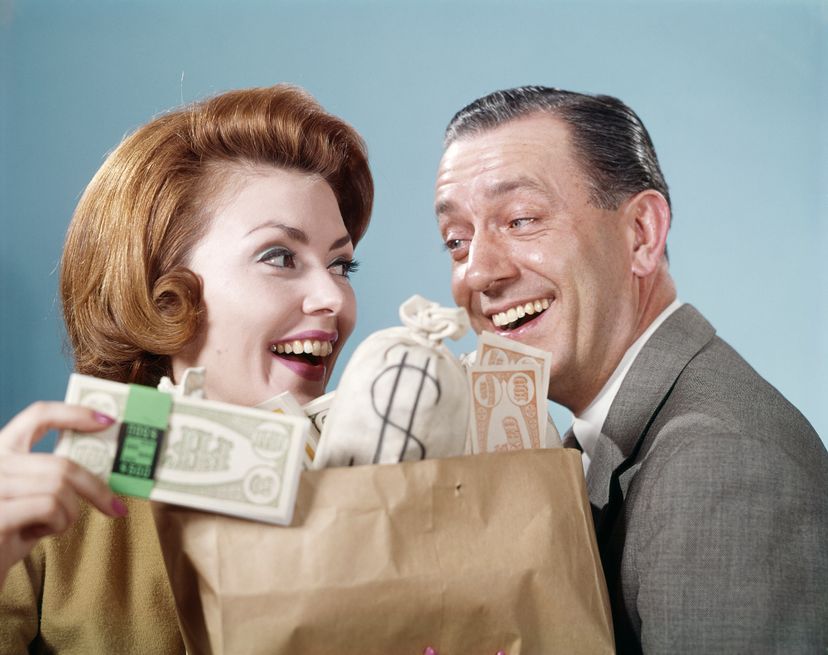
About This Quiz
Humans have assigned value to all kinds of things through the ages, from stones to spices. There’s even money made for potential encounters with alien life. How much is the intergalactic value of a Space Quid? The answer may surprise you!Canadian Tire money debuted in 1958 and could be used to make purchases at, you guessed it, Canadian Tire stores. The loyalty program is still in use today and represents more than $100 million awarded to customers annually.
Scientists in the U.K. have created the Quasi Universal Intergalactic Denomination (Quid) for space travel. The coin is made of a substance similar to that used in nonstick frying pans and avoids some of the problems created by traditional currency, such as the magnetic strips on debit cards that can be easily damaged in zero gravity.
The Katanga cross originated in the early 1900s in a copper mining region in Africa. Made of copper, it was shaped like a cross and ranged from a half-pound to 2.5 pounds. It was used as currency in the Democratic Republic of Congo.
Advertisement
Disney dollars can be redeemed at Disney resorts and parks, and on the company's trademark cruises. The currency, sold in $1, $5 and $10 denominations, looks like traditional paper money -- with the addition of the images of Mickey Mouse, Goofy or other Disney characters.
Kissi money ranges in length from 9 to 15 inches (22 to 28 centimeters), according to its value. Each bar is believed to contain a soul. If the bar became broken, the soul escaped. To repair the bar, a special ceremony was conducted by the local witch doctor who rejoined the pieces for a price.
America had a $100,000 bill that features an image of President Woodrow Wilson. The $100,000 bill, worth about $1.6 million today, was used only for transactions between Federal Reserve Banks and was discontinued in 1935.
Advertisement
You may receive a $1 million bill as a gag gift, but luckily this novelty currency isn't illegal. In 1982, the Secret Service investigated and determined the gag gifts weren't really forgeries.
Manchukuo was a short-lived state located in Manchuria from 1932 until the end of World War II. Its currency was the Manchukuo Yuan, which was made of a red or brown fiber similar to cardboard.
It may be a rare sight to see a $2 bill, but they are still in circulation -- even though the U.S. Treasury has printed more since 2006.
Advertisement
The 10 leva banknote has a number of watermarks, including a rhino, globe and narwhal -- an Arctic whale with a spiral tusk.
Tumeric is one of the world's most expensive spices. In the Solomon Islands, tumeric wrapped in coconut fibers was once used as currency.
Siamese porcelain tokens were first used in a casino game known as Fantan in the early 1800s. However, the delicate etched coins included 8,000 different designs and became so popular they were used throughout Siam (now Thailand) before the government banned them in 1875. The currency then became part of a black market trade and was used well into the 20th century.
Advertisement
Several Caribbean nations only began producing their own currency in the mid-19th century. Until then, they would recycle any foreign coins that entered their country by counterstamping it. For example, Dominica recycled by cutting a heart shape into the middle of foreign currency. This made the currency worthless in its country of origin but valuable on the island.
In 1690, the Massachusetts Bay Colony introduced paper currency to the Americas.
Rai stones couldn't be considered "pocket change," because they would never have fit in a pocket. These doughnut-shaped stones were used as currency on Micronesia's Yap island; some of the weighty stone coins measured up to 8 feet (2.4 meters) in diameter. The larger the coin, the greater its value.
Advertisement
One of the oldest currencies is salt. Compressed blocks of salt have been traded by people throughout the world, ranging from Roman soldiers to Sahara desert dwellers. And, testing the authenticity of this currency only required a lick.
When the British farthing was retired in 1956, its worth was equivalent to one-quarter of a penny.
After World War I, Germany attempted to rebuild its economy through the emergency printing of currency -- on everything from wood to playing cards.
Advertisement
In ancient China, bricks made of compressed tea (and sometimes twigs) were used as currency. The tea was compressed into bricks and then stamped with a symbol to convey its value. After the brick had served its value for trading, it could be steeped in hot water and consumed.
The British guinea was actually made of gold, which caused its value to increase with the price of gold. While the guinea was originally worth one British pound, its value was officially increased several times by the monarchy before it was retired in 1816.